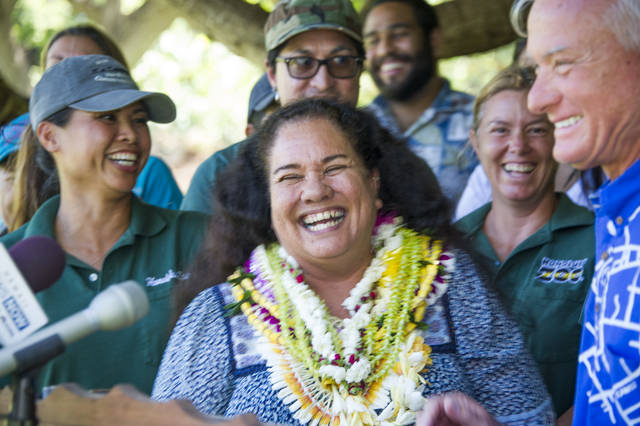On Monday, when Mayor Kirk Caldwell announced selection of the new Honolulu Zoo director — the fifth in roughly five years — it was clear that Linda Santos needs no learning curve. The Pauoa native has worked in various jobs at the facility since the mid-1980s, most recently as acting zoo director.
She succeeds Baird Fleming, who resigned in November — less than two weeks after Oahu voters approved a City Charter amendment that creates a funding stream fed by property tax revenues to help the struggling zoo regain accreditation with the Association of Zoos and Aquariums (AZA).
Honolulu Zoo lost accreditation in March 2016, when AZA faulted it for, among other things, having inadequate and inconsistent annual funding as well as instability in leadership due to a revolving-door situation in the director’s post.
Fleming, who was named to the top job in 2015, was credited with putting the facility on a road toward reaccreditation. However, he exacerbated the leadership problem when he left for a job on the mainland. Zoo supporters are cautiously optimistic about assurances by Caldwell and others that Santos is rooted in the local scene and committed to seeing through a successful reaccreditation.
The City Charter’s mandatory funding — half of 1 percent of annual property tax revenue — will initially bring the zoo $6.5 million to $8 million annually. The ballot success stands as a community endorsement for the 42-acre facility, which formally opened in 1947 and is the only zoo within a radius of almost 2,400 miles. But if it fails to secure reaccreditation, the new funding stream will run dry in July 2023 — and local backing for the current recovery plan would likely dwindle, too.
For now, it’s encouraging that zoo staffers appear energized by the selection of Santos, who rightly ranks increasing zoo admissions as a priority. Santos said: “I’d like to challenge people — if you haven’t come to the zoo lately, you need to come because we’re doing great things here.”
A bump in admissions would certainly brighten the zoo’s financial picture, which is somewhat dim even with the City Charter subsidy. In January, a city report found that zoo admissions fees account for 83 percent of the facility’s total operating revenue — and that declining attendance had placed a burden on the operating budget.
In the past, fiscal challenges were sometimes compounded when Honolulu Hale deferred money for zoo upkeep to fund other priorities, ranging from patching potholes to addressing homelessness.
That practice contributed to the zoo’s troubles with AZA, and has prompted some to suggest that Honolulu consider transferring responsibility for the facility from the city to a public-private partnership. Various other zoos have made that switch in an effort to avoid annual vulnerability tied to city funding.
Then there are zoo opponents, who contend that the 900 or so animals that now call the Kapiolani Park corner home should be cautiously reintroduced to the wild or relocated to natural refuges where they could roam freely.
To that, supporters counter persuasively that in addition to serving as a must-see for many Hawaii schoolchildren who otherwise would not have opportunity for an up-close look at orangutans and elephants, the Honolulu Zoo plays a vital role in protecting wildlife populations. For example, it claims a top record for breeding species ranging from Komodo dragons to Sumatran tigers.
Laura Debnar, curator for reptiles and the Keiki Zoo, said Santos “wants to see the zoo moving forward in conservation, and that is the modern way that zoos are going right now.”
The Caldwell administration wants to apply in 2019 for re-accreditation, key to securing federal grants as well as animal trade or loan deals with accredited zoos. Here’s hoping that with Santos at the helm and voter-approved funding now rolling in, the zoo will be able to work through its challenges — financial and otherwise — and successfully move forward.

